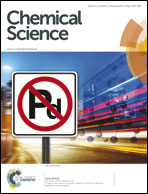Light-triggered strand exchange reaction using the change in the hydrogen bonding pattern of a nucleobase analogue†
Abstract
A light-triggered strand exchange reaction was developed using the change in the hydrogen-donor–acceptor pattern of a nucleobase analogue. We demonstrated that a new light-responsive nucleobase analogue derived from 4-hydroxy-2-mercaptobenzimidazole (SBNV) preferentially recognized guanine before photoirradiation and adenine after photoirradiation in duplexes. By using oligodeoxynucleotides modified with SBNV, a light-triggered strand exchange reaction targeting different mRNA fragment sequences was achieved. These results indicate that SBNV could be a powerful material for manipulating a nucleic acid assembly in a spatially and temporally controlled manner.


 Please wait while we load your content...
Please wait while we load your content...